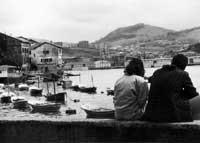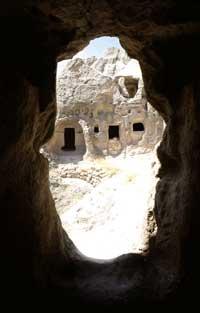Exhibition (and II): reading the exhibition
Elhuyar Fundazioa
The photometer tells us the clarity of the subject to photograph. This luminosity is controlled by the structure of tones and colors of the subject and by the intensity of the light source. Thus, each scene has its own scale of clarity, which becomes a scale of tones in both paper and negative. When the light is hard, we will have a scale of tones wider than when it is flat and diffuse, from dark shadows to strong lights.

When the distribution of the lights and shadows of the scene is balanced, since both occupy a similar surface, without moving around the place where we are going to take the photo, a general reading of this scene can be done (always directing the apparatus towards the area to be photographed) and the photometer will give an average value.
But the general reading (when the separation between shadows and lights is not so balanced, it is less) can lead us astray. In order for this not to happen, we must resort to selected readings, that is, to measure only the luminosity of the important part of the scene (and the point of average density of this part). This can be done by approaching it, doing a punctual reading or doing local readings with a portable spposimeter.
If you have a sposimeter or photometer that performs a general reading, you should approach the subject until it completes the entire viewfinder, do the reading and photograph the desired encoding with the value obtained.
If the photometer is punctual reading, you should direct the reading area to the area of interest. Since the photometer does not attend to the rest of the scene, it is not necessary to approach it.

Finally, it is easy to carry out local readings with the portable sposimeter (considering that there are no shadows in it). Reading can not only be done by measuring the light that reflects the subject, but also the light that reaches it. The latter, instead of directing the instrument towards the subject, is performed at the height of the subject and focusing on the light source, adapting the diffusing semisphere to the sensitive surface of the photometer.
On the other hand, it is intended to record as much detail as possible in some scenes with a wide range of brightness. In these cases, if time is available, the average between light and shadow readings tends to be performed, calculating on the one hand the reading of lights and on the other the reading of shadows and on the other the average value of them.

In action photos or in cases where previous alternatives are not worth us (when we can not approximate reasons, camera or photometer), we have the path of alternative reading. It is performed by measuring some medium pitch surface. This surface is usually gray cardboard or hand (equivalent to the face).
However, when it comes to high-contrast scenes, lighting and/or shadows are often lost. Normally, the film is not able to respond to a very wide pitch amplitude and if the exposure is suitable for shadows, the lights will be burned and vice versa. In these cases, we must learn to prioritize the elements of the scene and know what results we want to achieve.

Nor can the so-called security exposure be omitted. Most photographers recommend taking 3 or 4 more photographs just in case (reducing or expanding a point, two or half of the diaphragm), especially in photographs of great importance. They also recommend giving special importance to the suitability of the exhibition and not discard the rest.
As we have seen, the determination of adequate exposure is preventive. Normally you want as much detail as possible in the entire image. On other occasions, on the contrary, the chosen exhibition aims to show a part. Therefore, the choice of the exhibition will depend on the intentions of the photographer. Although the exposure suggested by the photometer is technically well, it is sometimes not the most beautiful and it is up to us to lengthen the exposure (increasing 1, 2 or 1/2 the diaphragm) or shorten it (reducing 1, 2 or 1/2 the diaphragm) to achieve greater artistic or plastic quality.
In any case, it is necessary to know well the latitude of exposure of the film or, what is the same, its ability to receive a scale of clarity. This capacity is, in short, the contrast of the film. For example, a slow black and white film has less margin than a quick emulsion. And the contrast interval of a slide is less than that of a movie.

What if we are without photometers? (for example by deterioration).
For this it is good to know some orientative data (in short, the information contained in the instruction table of the films): when it comes to a sunny summer day, the diaphragm of F16 and the speed figure of the film being used should be put at the shutter speed (if the film is 125 ISO, for example, the speed of 125). As it becomes cloudy, a diafgram point must be opened. On the other hand, if the shutter speed is to be modified, the corresponding diaphragm must be adjusted. It is an outdoor solution.





